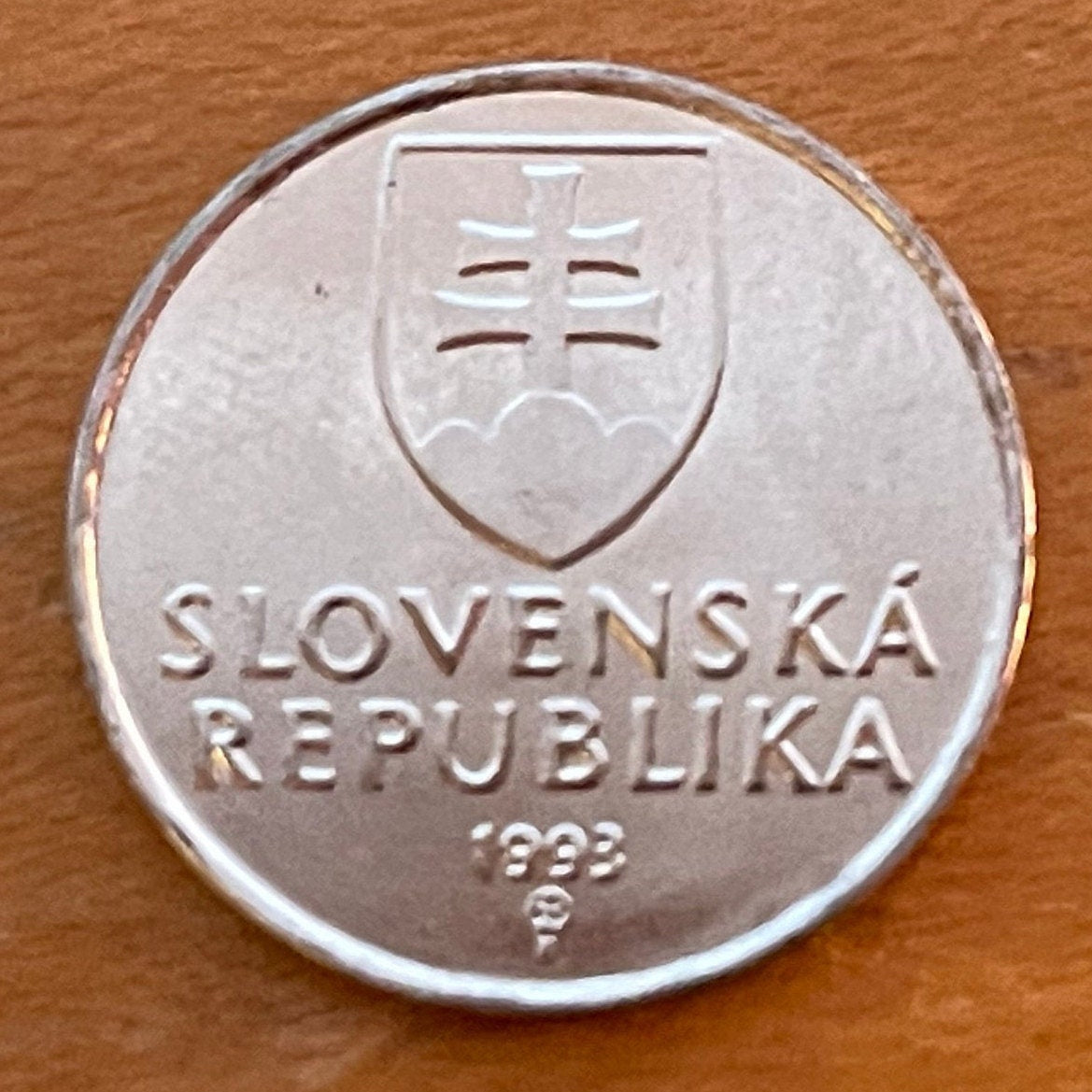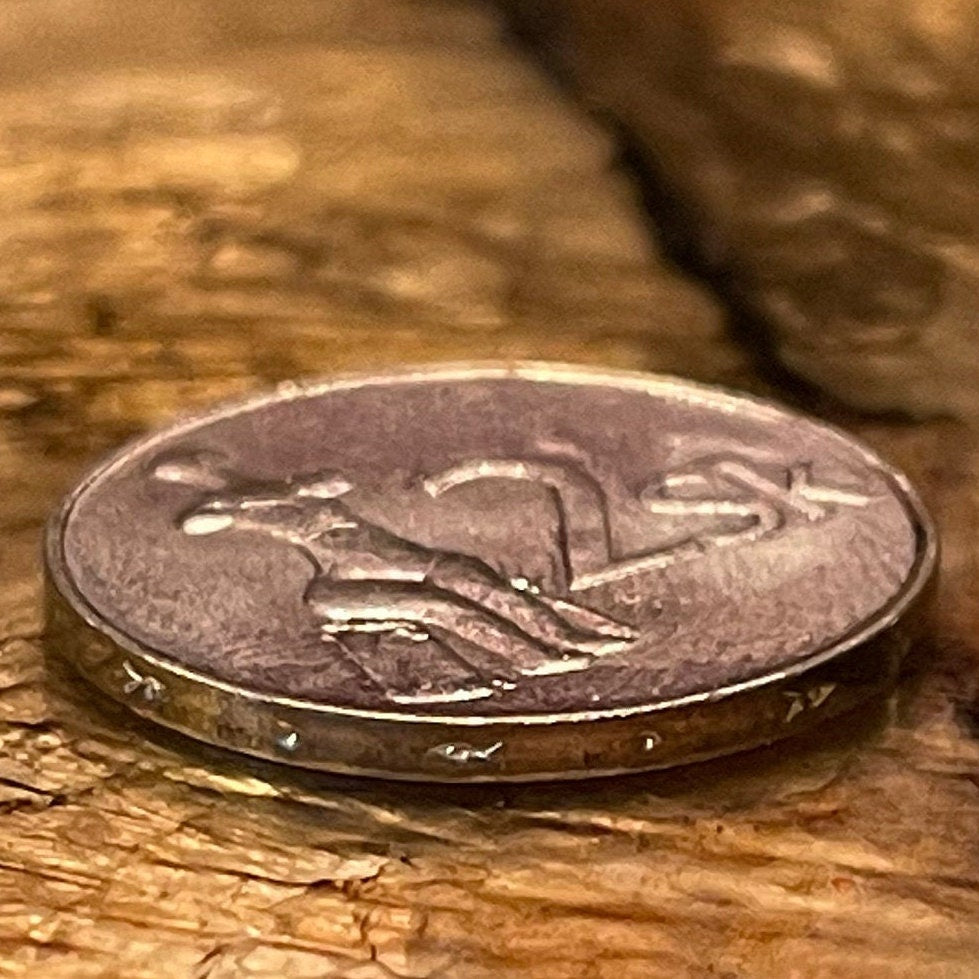elemintalshop
Venus of Hrádok 2 Koruny Slovak Republic Authentic Coin Money for Jewelry (Jaroslav Gubric) (Hrádocká Venuša) (Neolithic) (Slovak Troy)
Venus of Hrádok 2 Koruny Slovak Republic Authentic Coin Money for Jewelry (Jaroslav Gubric) (Hrádocká Venuša) (Neolithic) (Slovak Troy)
Couldn't load pickup availability
Venus of Hrádok 2 Koruny Slovak Republic Authentic Coin Money for Jewelry and Craft Making (Jaroslav Gubric) (Hrádocká Venuša) (Neolithic Figurine) (Slovak Troy)
Reverse: Monumental Sculpture by Jaroslav Gubric of the Neolithic figurine of sitting Venus ("Venus of Hrádok") discoverd at Nitriansky Hrádok, the so-called Slovak Troy.
Lettering: 2Sk
Translation: 2 Slovak Koruny
Obverse: The Slovak shield above the country name, all above the date
Lettering: SLOVENSKÁ REPUBLIKA
Translation: Slovak Republic
Features
Issuer Slovakia
Period Republic (1993-date)
Type Standard circulation coin
Years 1993-2008
Value 2 Koruny (2 SKK)
Currency Koruna (1993-2008)
Composition Nickel plated steel
Weight 4.4 g
Diameter 22.5 mm
Thickness 1.7 mm
Shape Round
Technique Milled
Orientation Medal alignment ↑↑
Demonetized 17 January 2009
Number N# 2485
References KM# 13, Schön# 16
Wikipedia:
Nitriansky Hrádok is a district of a town of Šurany, Slovakia. This settlement was annexed to Šurany in 1976. A significant quantity of archaeological material has been found at the tell of Zámeček (the name means "small castle", "château"), settlement layers of which have been estimated to date from about 3,000 BC. For this reason this place has become known as the "Slovakian Troy".
A famous find was a neolithic figurine of a sitting woman, which was dubbed Hrádocká Venuša, or the Venus of Hradok. "Venus" is an umbrella term used in archaeology for objects of this type. The figurine was depicted on Slovakia's two-koruna coin. In 1997 a statue by Jaroslav Gubric was erected at Hradok, an enlarged copy of the figurine.
*******
Wikipedia:
A Venus figurine is any Upper Palaeolithic statuette portraying a woman, usually carved in the round. Most have been unearthed in Europe, but others have been found as far away as Siberia, and distributed across much of Eurasia.
Most date from the Gravettian period (26,000–21,000 years ago). However, findings are not limited to this period; for example, the Venus of Hohle Fels dates back at least 35,000 years to the Aurignacian era, and the Venus of Monruz dates back about 11,000 years to the Magdalenian. Such figurines were carved from soft stone (such as steatite, calcite or limestone), bone or ivory, or formed of clay and fired. The latter are among the oldest ceramics known to historians. In total, over 200 such figurines are known; virtually all of modest size, between about 3 cm and 40 cm in height. These figurines are recognised as some of the earliest works of prehistoric art.
Most have small heads, wide hips, and legs that taper to a point. Arms and feet are often absent, and the head is usually small and faceless. Various figurines exaggerate the abdomen, hips, breasts, thighs, or vulva, although many found examples do not reflect these typical characteristics. Depictions of hairstyles can be detailed, and especially in Siberian examples, clothing or tattoos may be indicated.
The original cultural meaning and purpose of these artifacts is not known. It has frequently been suggested that they may have served a ritual or symbolic function. There are widely varying and speculative interpretations of their use or meaning: they have been seen as religious figures] an expression of health and fertility, grandmother goddesses, or as self-depictions by female artists.
Source below: https://www.kamnavylet.sk/en/attraction/statue-of-venus-of-hradok --
The statue of Hrádok's Venus will probably be remembered by many of you, especially from a coin worth two Slovak crowns. Venus of Hrádok is actually the first found Neolithic statue to depict a sitting woman.
To this honour, the small statuette was efficiently transformed into a 2.7 meter high portrait. It is a monumental memorial, which is a magnificent copy of the original statue of Hrádok's Venus. The author of this sculpture is the artist Jaroslav Gubric.
The Statue of Hrádok's Venus stands on the pedestal in a park in Nitrianský Hrádok, surrounded by a colorful flowerbed of various flowers and ornamental shrubs.
There are also benches in its vicinity, so many visitors can perfectly enjoy this magical atmosphere and you can also think a bit about the life of people from the Stone Age.
*****
Wikipedia:
The coat of arms of the Slovak Republic consists of a red (gules) shield, in early Gothic style, charged with a silver (argent) double cross standing on the middle peak of a dark blue mountain consisting of three peaks. Extremities of the cross are amplified, and its ends are concaved. The double cross is a symbol of its Christian faith and the hills represent three symbolic mountain ranges: Tatra, Fatra (made up of the Veľká Fatra and Malá Fatra ranges), and Matra (in northern Hungary).
Double cross
One of the modern interpretations of the double cross is that it represents Slovakia as an heir and guardian of Christian tradition, brought to the region by St. Cyril and St. Methodius, two missionaries from the Byzantine Empire.
The two-barred cross in the Slovak coat of arms originated in the Byzantine (Eastern Roman) Empire in the 9th century. Unlike the Christian cross, the symbolism and meaning of the double cross is not well understood. One interpretation is that the first horizontal line symbolized the secular power and the other horizontal line the ecclesiastic power of Byzantine emperors. Another that the first cross represents the death and the second cross the resurrection of Jesus Christ. In the Byzantine Empire of the 9th century, the double cross was a political symbol used by Byzantine clerks and missionaries.
The double cross arrived in the territory of current-day Slovakia probably no later than during the 9th century mission of Cyril and Methodius to Great Moravia. Though used frequently in Great Moravia, it was not a state symbol at that time, because there were no state symbols in the modern sense in Europe at that time yet. By means of Zwentibold (the ruler of Lorraine, son of the German emperor Arnulf of Carinthia and godchild of the Great Moravian king Svatopluk I), this symbol got to Lorraine and is called the cross of Lorraine there.
The double cross symbol appeared again in rudimentary features on the first coins that Stephen I, the first king of the Kingdom of Hungary (part of which now forms the territory of present-day Slovakia), had minted at an unknown place. Before he became king in 1000, he was the Grand Prince of the Principality of Hungary and was living there with his Bavarian wife Gisella. The frequent opinion that the double cross was a cross that the Pope granted to Stephen I. around 1000 is still disputed. The opinion arose only in the 15th century based on a legend from the 12th century, which in addition only says that Stephen received an apostolic cross (i.e. a normal, not a double cross).
Share










Lovely and surprising coin, just as advertised. Shipped very promptly, thank you!









